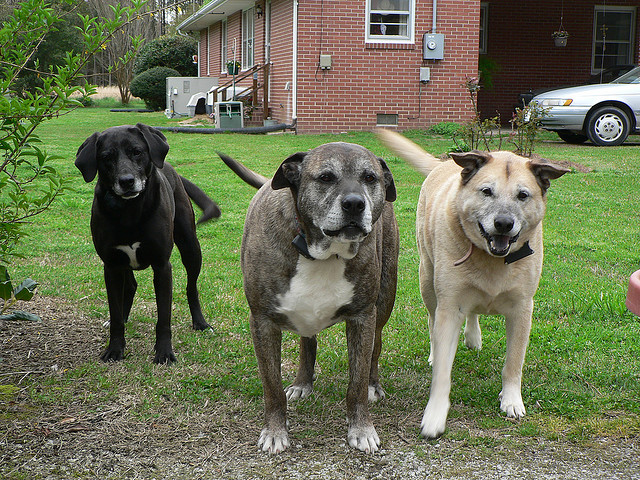You never know when nature is going to take control of the environment for better or for worse. This means you need to be prepared for any occasion and make sure your pets are covered too.
Do you currently have your pets needs covered in your earthquake, tornado and or disaster kit?
Most people forget about the really important things for a pet, like food, enough water and any medication they might need. Basically everything important that you would cover for yourself or other family members should be covered for your fur baby as well. Any one would feel even worse in disaster situation if they didn’t prepare for every member of the family.
Check out one persons own experience, and then make sure you have the 8 items below it covered for your pets in your emergency kit
“You never think it’s going to happen to you,” says Justin Tranchita. Justin and his English Bulldog, Oscar, appear on the Discovery Channel reality show Game of Pawns set in a Branson, MO, pawn shop.
On February 29, 2012, when Oscar was just a puppy, a 400-yard-wide tornado with winds of 120 to 130 mph blew through Branson. “When the tornado alarms went off and the trees started to blow sideways, I was in complete terror and shock,” Justin says. “Oscar and I ran into the bathroom like Shaggy and Scooby! We hunkered down in the tub. I remember squeezing his fat little body so tightly!” Justin’s family wasn’t home at the time. Fortunately, the tornado hit half a mile away. Justin’s home suffered some wind damage, but his father’s store was completely destroyed. After the storm, Justin took tornado preparation more seriously. He moved to a home with a tornado shelter. He packed an emergency bag for Oscar containing canned food, doggy toys, and bottled water. Justin takes Oscar into the safe room whenever a Tornado Watch is announced.
Justin’s kids have even taught Oscar an evacuation code word that sends him to a specific place in the home. Way to go, Justin!
1. Get identification. Tags can be lost, but a microchip is forever. If you are separated during a tornado, a chip gives you and your dog the best chance of being reunited. Make certain to register the chip with a national registry database, and keep the info current should you move or change phone numbers. Also, carry photos of your dogs on your cell phone and give copies to family outside your immediate area. The pictures can help prove ownership and can be placed on lost pet posters.
2. Know what you’ll do before it happens. If you don’t have a basement or tornado shelter, don’t panic. Designate a safe room in the smallest, innermost room on the lowest floor of your home. The room should have no windows, skylights or glass doors. Great safe-room choices include an interior bathroom or closet or under-stairs storage.
3. Know weather terminology. Pay attention to the weather forecast. If there’s a potential for severe weather in your area, keep your ear tuned to the TV, radio or Internet for further advisories. If severe storm watches are issued for your area, that’s your cue to protect your dog — don’t wait until the spit hits the fan.
4. Take cover. On an average, you’ll only have 13 minutes notice. Put both dogs and cats in a carrier. If your safe room happens to be the laundry room, you can put small pet carriers inside your dryer, with the dryer door open,” says Paul Purcell of Disaster Prep 101. “The dryer, being a double-walled metal appliance, offers extra layers of crush and projectile protection.”
5. Practice your plan. Practice leashing your dog and calmly leading him to your safe room. Better still, train him to go to the shelter on command. And don’t forget to bring the treats and toys.
6. Dangers in the aftermath. After the storm has passed, don’t let your pets outside until you get the all-clear from local officials. Broken glass, sharp sticks, exposed nails, downed electrical lines and jutting rebar can cause a host of injuries.
7. Know what to do if your pet escapes. If you and your dog become separated, know where to search for lost animals. During a disaster, strays are usually taken to your animal control agency or humane society. That’s when you’ll be grateful you had that microchip and cell phone photos. Keep the animal shelter’s phone number in your cell phone directory.
8. Maintain emergency provisions. “Assembling a small emergency kit for your pet is a wise move,” says Jim Cobb ofSurvivalWeekly.com. Even if the storm doesn’t strike you directly, you may experience power, water and/or phone disruptions. Keep your emergency provisions in waterproof containers in your safe room, if possible. Maintain a two-week supply of dog food, water and medications for each pet in case you have to shelter in place.
Your shelter kit Go Bag should include:
- a pet first-aid kit
- a properly sized carrier
- disposable bowls and plastic spoons
- a favorite toy or blanket
- harness, leash, and muzzle
- plastic bags for poop disposal
- your dog’s favorite comfort foods
- a copy of your dog’s immunization record.
Image Source: Fadil Basymeleh on Flickr





Leave a Reply